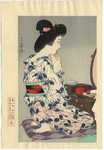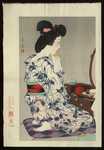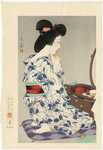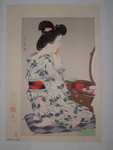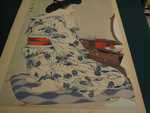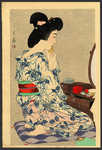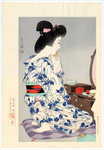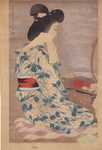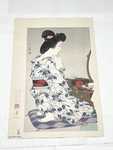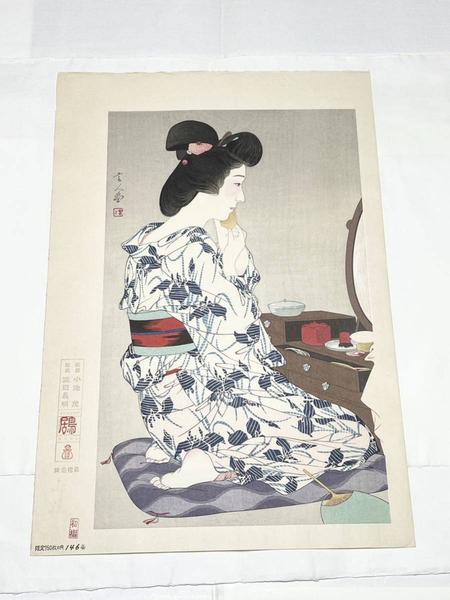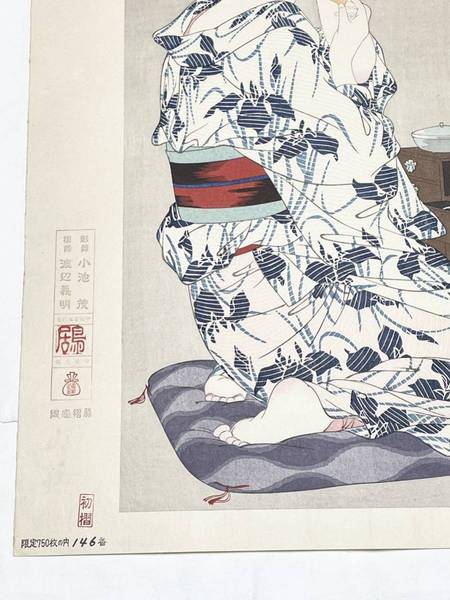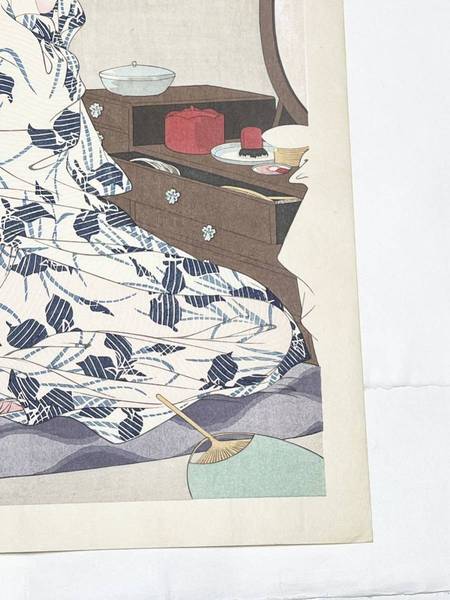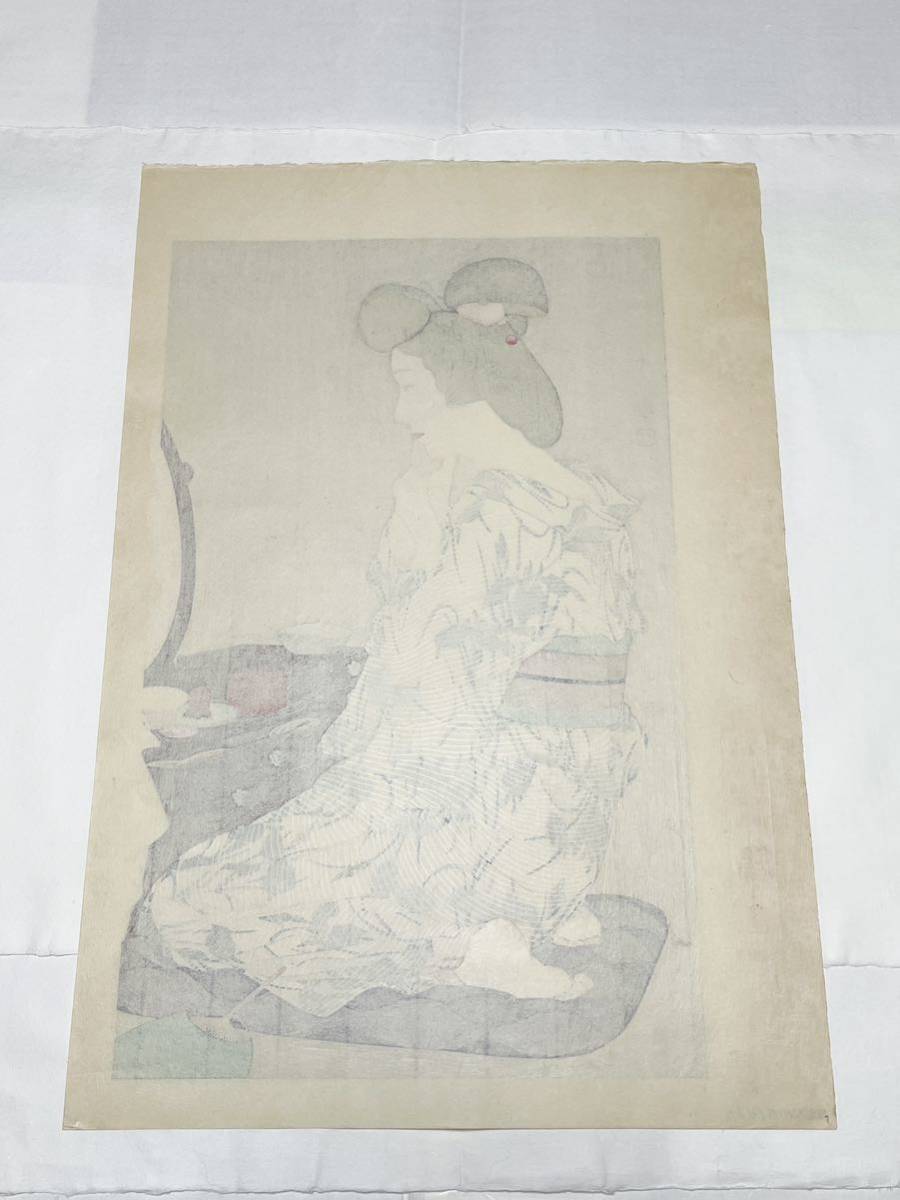| | |
| Artist: | Torii Kotondo (1900-1976) — 鳥居言人 |
| Title: | Light Summer Kimono with Irises - Ayame Yukata — 菖蒲ゆかた |
| Series: | |
| Date of first edition?: | 1932 |
| Publisher (first edition)?: | Ikeda — 池田 |
| Publisher (this edition)?: | Ishukankokai — 遺珠刊行会 |
| Medium (first edition): | Woodblock |
| Medium (this edition): | Woodblock |
| Format (first edition): | Large Oban
|
| Format (this edition): | Large Oban |
| DB artwork code: | 47975 |
| Notes (first edition)?: |
Artist Kotondo (1900-1976)
Title Ayame Yukata
Dated 1932 (confirmed. Month not yet confirmed).
Limited edition of only 100 prints, after which the blocks were destroyed.
Scene number 6 among 12 Ikeda published scenes.
Publisher Ikeda
Dimensions 19.5 x 11.5
Notes Ayame Yukata means "Cotton Kimono with Iris Pattern".
Reference: The Female Image, 2000, p. 131, pl. 176
Re-issued in the series "Twelve Aspects of Women" circa August 23, 1988.
Note: there are a lot of pre-war examples of this scene that do not have edition numbers. They are sometimes mistakenly listed as being edition 4. See my article about Kotondo edition labels here. |
|
| Notes (this edition)?: |
| The following information was taken from the original web listing of this artwork. Note that there may be some inaccuracies:
・五代目 鳥居清忠こと鳥居言人(ごだいめ とりい きよただ、明治33年〈1900年〉11月21日 - 昭和51年〈1976年〉7月13日)は大正時代から昭和時代の浮世絵師、日本画家、舞台美術家。鳥居派八代目当主。鳥居言人として知られる。
・四代目鳥居清忠及び鏑木清方の門人。東京府東京市日本橋区日本橋蛎殻町(現中央区日本橋蛎殻町)に生まれる。姓は斎藤、名は信。言人(ことんど)、清言(きよのぶ)と号す。父は芝居絵の鳥居家七代目の四代目鳥居清忠であった。
始め父清忠に歌舞伎座の絵看板などの鳥居派の技法を学び、言人と称し、さらに小堀鞆音に就いて大和絵や有職故実を学び、後に1918年にその紹介で鏑木清方の門に入り美人画を学んだ。作品は清方や伊東深水の影響を受けており清楚な画風の肉筆浮世絵や挿絵を描いている。
木版画では昭和4年(1929年)の美人画連作、「おんな十二題」、「化粧」、「雪」、「湯浴み」などが代表作としてあげられる。「長襦袢」では長襦袢の模様、色、背景などを変えた5種類の作品が制作された。
木版画の落款は「言人」を使用している場合が多く、「清言」に改名後も使用している例がある。昭和51年(1976年)、75歳で死去。墓所は台東区妙顕寺。
・貴重な初摺り版(限定750枚)になります。
・真作の木版画の美人画浮世絵です。
・個人所有のこの1点のみになります。
・版画のサイズ(慨寸)=たて48cm×よこ33cm。
・版画の状態=写真ご参照ください。年代のものとしては、基本的な状態はおおむね良好から並の上。 |
|
| Artist Bio: |
| Torii Kotondo (or Torii Kiyotada VIII) is renowned for his paintings and shin hanga prints of beautiful women. His woodblock prints, superbly carved and printed, are comparable with those of Hashiguchi Goyo and Ito Shinsui. Kotondo was born with the name Saito Akira in the Nihonbashi district of Tokyo. He was the only son among the five children of Torii Kiyotada, the seventh Torii master. The Torii school had a long tradition of painting and printmaking for the Japanese theater, extending back to the seventeenth century. Kabuki theater was still very popular in the early twentieth century and prints and painted posters were the primary means of publicity. Although Kotondo was mainly interested in studying history and archaeology, it was assumed that he would follow in his father's footsteps and join the Torii school. At age 14, Kotondo agreed to leave school and begin studies with Kobori Tomone, a yamato-e painter. Along with painting classes, Tomone taught Kotondo about the court and military practices of ancient Japan, satisfying his interest in history. A year later, he was officially adopted as the next heir of the Torii school and assumed the artist's name 'Kotondo'. While still studying with Tomone, he began designing illustrations for a theatrical magazine, Engei Gaho ('Entertainment Illustrated Magazine'), and painted kabuki posters and billboards. Torii Kotondo was the 8th Torii and the 5th Torii Kiyotada. His father was the 4th Kiyotada.
|
|



